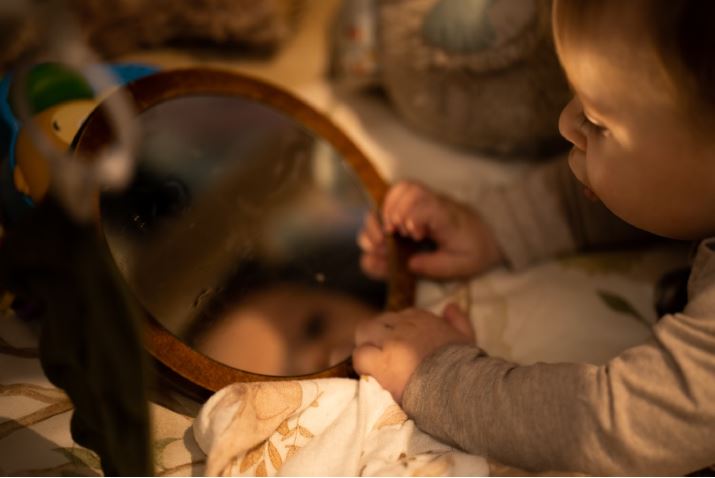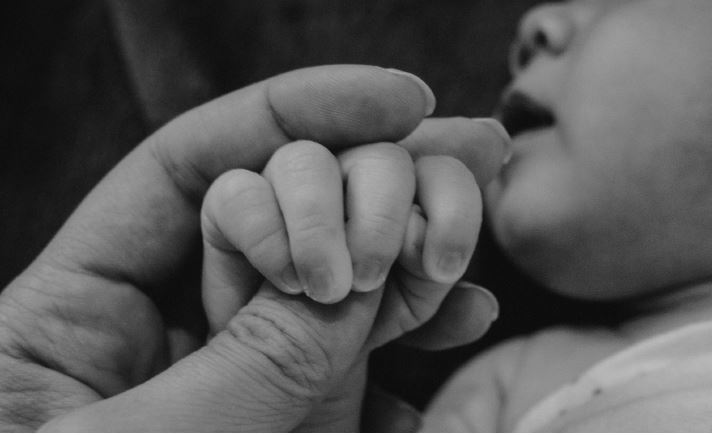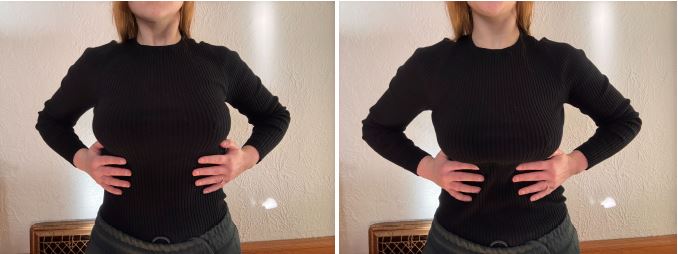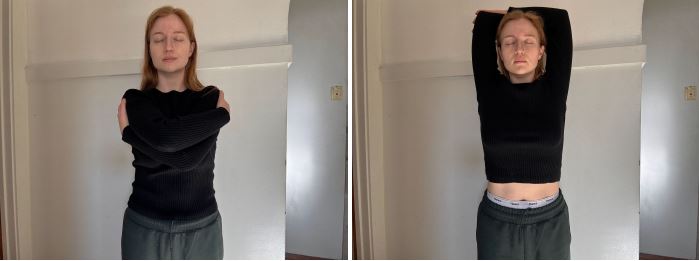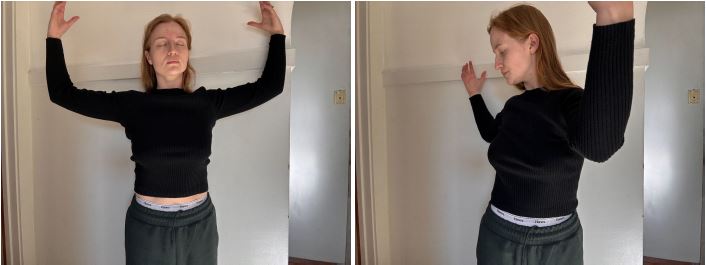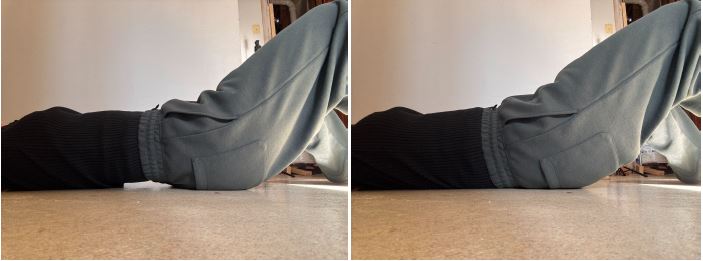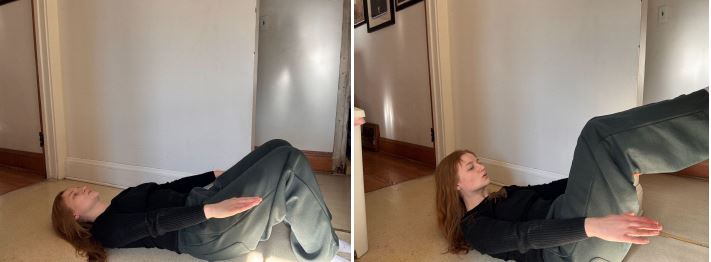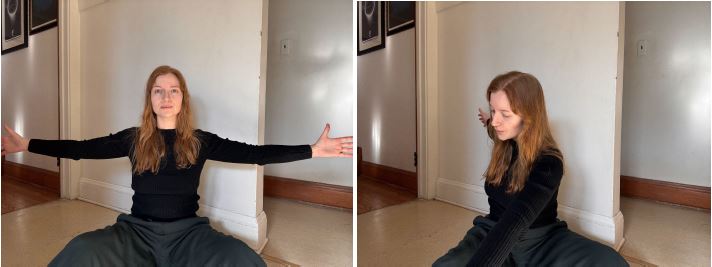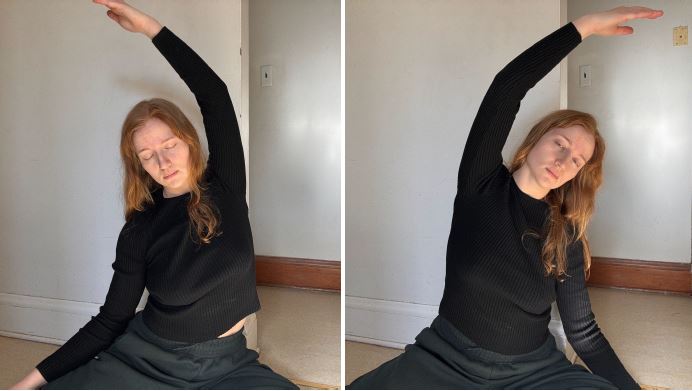Your Breath is Your Divinity: The Transformative Power of Breath and Pilates During and After Pregnancy
Nov 19, 2025
Your Breath is Your Divinity:
The Transformative Power of Breath and Pilates During and After Pregnancy
Dear Reader,
Before we dive into today’s discussion, I’d like you to take a moment for you: If you’re on your phone or laptop in a noise-filled space, that is okay, what matters is your presence. Close your eyes, maybe you even put a hand on your chest or opened palms in your lap. Take a deep inhale through your nose, imagine a glowing ribbon of light swirling in your chest as you breathe it in. Now, exhale slowly through your mouth, as that ribbon fractals all throughout your body- spreading to your fingertips, womb, hips, knees, toes, and filling the room about you. You, in one breath cycle, have just behaved as a prism for the warmth of love that we are all connected through- the love that your body emerged from, and the love your body grows your little one through. How do you feel?
The Impact of Breath and Pilates
To quote the innovative powerhouse who was and is Joseph Pilates, “Breathing is the first act of life and the last. Our very life depends on it.” And famously, “Above all, learn how to breathe correctly.” Our breath is the life force that enables not only our bodies, but our minds, emotions, and even our spiritual connections. When we weave our breathing with our movements, we turn off the involuntary and tune into mindfulness- moving with intention and control. This is why Joseph Pilates was such a breath “evangelist”, and why we Pilates instructors still to this day cue specific inhales and exhales through different actions- they help us fi ne tune and gain control over our bodies, simply by getting back inside of them. Breathing calls us to ground back down inside of ourselves, in a world and life that distracts and pulls us in seemingly one thousand directions simultaneously. Deep breathing regulates our nervous systems, nervous systems that have become all-too-accustomed to being dysregulated. Breathing lowers our blood pressure when a consistent flow of Oxygen is able to flow into our bloodstream. Imagine how when we breathe to benefit our most vital systems in this way, we also support and benefit our growing little ones?
Breathe Love Into Your Body, Exhale Judgement
While our breath impacts us from the inside out, so do the words we carry on those breaths… and in our minds. If looking in a mirror at the moment is not something you are in a space to do, please know that this is alright, and honor your journey. However, if you are comfortable with it, I would like you to take a look in front of your mirror and just notice your thoughts- I know, thinking about your thinking sounds pretty Meta, right? More so, just take note of the first things you notice about yourself, the first words your brain tells your body, and how they make you feel? Are they kind? Are they nitpicking? Are they seeing you as little imperfections first, or are they seeing you as a unique topography that no one else can ever be?
As someone who has struggled with her own Body Dysmorphia since five years old, I know the sea of emotions that can come with this exercise. I myself simply watched my mother poke and prod her body through her pregnancies with my younger siblings, and listened to how she spoke about her body. It has taken years of therapy and work to realize that the way I judged my body was not mine, but something inherited as a wound. To many, this story might feel and be all too familiar. Please remember, this isn’t about being obsessed with your body. You do not have to be in love with how you look, you also do not have to loathe how you look either- I want you to begin to see the YOU that goes beyond your reflection. If not for you, speak kindly about your body aloud for your little one. I understand- when I am feeling unattractive and judging my body, saying “I am so grateful for my body and the power it gives me” can make me want to wince. Nevertheless, your little one is absorbing and mirroring everything you say and do- and this is how my own mother unintentionally taught me how to relate to my own body, and how her mother taught her the same. You are their map for self-relation, especially in the early developmental years.
I know- this is not a quick fi x, this is a practice of patience to be fostered and nurtured each day. Simply by beginning with a thank you to your body, not just the outside, the whole body. Gratitude for the taste buds you have that allow you to taste delicious meals, for your arms that allow you to hold those you love, for your heart that allows you to exist, your brain that allows you to navigate life. Hey, how about the fact that you are literally growing a human being inside of you, right? This goes for body patience as well, especially during the Postpartum period which lasts up to 2 years after birth. Instead of trying to “bounce back” let’s focus more on moving forward as we bond with our baby and allow our bodies to heal! Look at the shifts your body has gone through as proof of your resilience, and know that we have nothing to try to “fi x” or “lose”, it is all about the gains here- gaining strength, gaining flexibility, gaining self-compassion.
Remember, you are Divine. Whether you believe in a higher power or not, your body is quite literally formed out of stardust and connected with The Cosmos infinitely. Take a look around- notice how the cellulite and stretchmarks resemble ripples in the sand, how our blood veins resemble molten lava, and how our eyes resemble the galaxy and seas? The next time you gaze into your mirror, remember you are literally a miracle.
The Power of Your Daily Habits and Movements
While I myself will vouch for Pilates until the cows come home, remember that a Pilates session is 30, maybe 60 minutes out of your day. This means that while it is incredibly impactful, what you do the other 23ish hours of your day will play an even more vital role in your strength, recovery, and overall health. It is not what we do some of the time, it is what we do most of the time. So, the first step is building self awareness: when you sit, how is your posture? When you drive, walk, stand in line, wait by the gas pump, scroll on your phone- how are you oriented? When you open the oven, lift the trunk of your vehicle, carry a box- how are you breathing? When you bend over to pick something up, how does your back feel? These are the constants and daily habits that can strengthen, or slowly harm, our bodies. So, here are some practical ways we can improve our daily movements:
1. Stay aware of your posture: Staying lifted with shoulders relaxed allows for more effective breathing and organ orientation, whereas slouching puts strain on the back, compresses organs, and often leads to migraines.
2. Exhale on exertion: When you squat down to pick something up, exhale as you stand up. When you exert any pull/push force, like opening a car door, or pushing a cart, exhale. When you pick up your baby, exhale. This makes your actions voluntary and better regulates your air and blood.
3. Always lift from the legs: When lifting things, especially over ten pounds, bring it in close and bend knees to stand up with said thing.
4. Try to move around every 20-30 minutes: Even at the office, after this amount of time lapses, just standing up for a quick walk to the bathroom keeps our fascia and blood flowing more effectively.
5. Bring in more joy: Yes, our attitude towards what we do not only impacts our mood, but impacts how our body feels and how our babies feel! Think of it this way, you don’t feel like sweeping, so you scowl and think about how you hate sweeping. Your face scrunches, body tenses, and now your body is feeling off and straight up grumpy. Totally understandable. But then you bring your baby to your chest in a bjorn, and they see your face, feel your heart rate increase, and your body language tense- how do you think they will innately respond? The more calm and regulated your system is, the more regulated your baby is. This is directly impacted by your thoughts. Make the mundane more magical by playing music or a podcast you love, dance while you sweep, talk to your baby! Nothing is mundane when you see the magic in everything!
Let’s Get Into The Pilates Exercises!
*Quick Mythbusting Time* Great news, there is NO, I repeat, NO evidence based research to date that exercise is dangerous during pregnancy, or causes miscarriages. Exercise does not cause miscarriage. Further, It is not exercise that is a risk during pregnancy, rather, how an exercise is executed and moved through during each trimester.
With that being said, we’ve discussed the power of breath and movement on our whole beings, now is the fun part! Below are a handful of some of my favorite Pilates exercises that we can practice in our day-to-day lives. Images and demonstrations are all yours truly, let’s get into it!
1. 360 Diaphragmatic Breath
Learning diaphragmatic breath maximizes our oxygen intake, while learning to engage our core muscles and condition our Pelvic floor muscles with each exhale.
● To start, whether you are sitting or standing, place one hand on each side of your ribcage. Relax your shoulders and deeply inhale through your nose until you cannot expand that “balloon” further. Then, exhale deeply through your mouth with a sigh or imagine blowing through a straw to “empty the balloon”. With your inhale, try to press your ribs into your hands expanding them, and with the exhale, try to pull ribs in towards your center “closing” them- this engages our external obliques. When you breathe properly, you naturally condition your pelvic floor. As you inhale we expand and stretch the floor, and as we exhale, we contract the pelvic floor.
2. Hug The Baby/Hug The Belly
Naturally following diaphragm breathing, is focusing on how we engage our entire corset of muscles to support us and our babies.
● To hug the baby, I want you to first think of your core as lower abs (above the uterus), middle abs (waistline), and upper abs (wrapping around the bottom of the ribcage). Standing or sitting, feel your feet connect to the ground, relax your shoulders and look forward. Use your inhale to relax your stomach or “release the baby” as we see in the next image. Then, as you exhale, imagine you are zipping up a pair of jeans that are too tight, starting by drawing in and up- first lower, then middle, then upper abs. Imagine you are trying to hug your baby up and into your ribcage (or organs, if you are postpartum).
3. Blooming Flower & Rib Wriggle
With all of the upward pressure caused by your growing baby, this movement allows us to relieve that organ compression, strengthen, and stretch our upper back muscles. Despite what you may have been told about reaching overhead (Myth Busting Alert!) there is NO supporting evidence-based research on overhead reaching being dangerous during pregnancy. In fact, done mindfully, this not only offers relief but conditions us to reach overhead with less risk of injury, giving us a moment to move our shoulders in all four directions!
● First, stand with feet about hip distance apart and feel your feet connect with the ground. Then, give yourself a hug, fi nd the edges of your shoulder blades with your finger tips. Hug The Baby, and then bring that arm-shape up over your head. Pause here, feel the stretch and take a deep inhale. Draw your arms back into a goal-post position as you relax your shoulders. Then, gently wriggle, rotating side to side, as you fl oat your arms down with that exhale. Repeating 3-6x as desired.
4. Active Squat & Resting Squat
Glute strength is a must for pelvic and spinal alignment and support. Beyond the visual benefits of Glute strength for moms and moms-to-be, think of how often we squat down to pick up a basket, a squirmy toddler, a dropped book. Do you feel strain on your lower back? It may be that your core and glute muscles are not holding up their end of the bargain- so let’s get them involved!
● First, The Resting Squat: Stand with feet wider than hips, and perhaps turn toes out if this feels better on your hips. Sit back into your heels, and sink your pelvis towards the floor. Here you can grab a counter top, the wall, or balance holding knees if you feel okay to do so. Gently shift side to side and take a few breath cycles, opening the anterior pelvis and finding that stretch. Note: this is a WONDERFUL birthing position.
● Next, The Active Squat: stand with feet slightly wider than hips and, as with resting squat, hug the baby and sit back into your heels, hinging forward at the hips. If picking something up, pull the object closer to your core to keep pressure off back. Inhale at the bottom, and exhale as you press into heels and stand up! Note: Always exhale on exertion!
5. Gentle Hanging
Similar to the blooming flower, this movement allows us to relieve organ compression, and stretch our upper back muscles. Once you are in your second trimester and beyond, just take it slow, and start by leaning into these stretches to about 50% of your range. Your body is PUMPING with the Relaxing hormone in preparation for labor at this phase- put simply, you are extra stretchy and we do not want you dislocating a shoulder.
● Find a doorway, and if you cannot reach the top of the door frame, hold the edges or *CAREFULLY* stand on a stool with bent/softened knees. Holding the frame, slowly sink down and feel the stretch through your lats, obliques, sides, and armpits. Take a few breaths here. For an added lateral stretch, walk both hands to one side and hang, repeat on the other side. For an even deeper stretch, hand from one arm and gently look down towards the dangling arm, repeat on the other side.
6. Pelvic Rocks
Pelvic rocks are my #1 go to movement for abdominal and glute engagement, as well as for building pelvic awareness, and spine awareness. They are also excellent for relaxing the nervous system as we pair intentional breath with gentle movement.
● Note for 2nd & 3rd Trimester: If you are comfortable on your back, stay there with head and feet down as pictured. Otherwise, you can prop your back against a ball, sit on heels with hands on the floor, or even lie down with your head on a pillow. It is important to keep the heart above your baby to protect blood flow at this stage.
● Whether lying down or kneeling, start by taking a deep inhale through the nose filling the ribs. As you do this, fi nd a small space under your lower back as your pelvis tilts forward (this is what we would refer to as a neutral spine). Then as you exhale, hug the baby in and flatten your spine into the mat (imprinting) tilting the pelvis backwards. Repeat 3-6x, this is gentle pelvic rocking. You can also do this rock side to side as pelvic tilts!
7. The Hundred
The Classical Hundred- what can’t it do? Increase lung capacity, breath endurance, whole body integration, back to arm connection, abdominal wall conditioning, rhythm and heart stimulation, it has green checks across the board!
● Note for 2nd & 3rd Trimester: If you are comfortable on your back, stay there with head and feet down as pictured. Otherwise, you can prop your back against a ball, a chair, or even high kneel. It is important to keep the heart above your baby to protect blood flow at this stage.
● For the Hundred, we are focused on inhaling for the count of 5, and exhaling for the count of 5, as we rhythmically pump the arms up and down. No matter what position you choose, we are reaching long energy through the fingertips, relaxing the shoulders, hugging the baby in to engage core and pumping as we go through these breath cycles. I usually breathe and pump as follows- “Inhale, 2,3,4,5, Exhale,2,3,4,5” and Repeat up to 10x. Note: if you feel dizzy at any point, pause. Your Oxygen fl ow is increased to supply your baby during pregnancy- this can lead to dizziness more quickly.
8. Saw
The Saw is an excellent way to strengthen your core, bring in some gentle rotation, and fi nd a deep stretch through the side body and back of the legs.
● First, sit up tall on a mat or with your back propped up against a ball. Arms are outstretched with palms forward, and knees slightly bent. Imagine a string is pulling you tall through the top of your head, think up, levity, lifted! Next, take an inhale and gently rotate to the right. Then lean forward and reach your left pinky towards your right pinky toe. Here, gently glide (or saw) back and forth three times. Exhale each time you pulse. Then, rotate back to center and repeat on the other side. Each time you rotate, remember to hug the baby and relax into your sitting bones.
9. Mermaid
A wonderful exercise for opening the chest and diaphragmatic cavity, deeply stretching the sideline of the body, opening up our hip flexors and bringing in spinal movement.
● Begin by sitting, either criss-cross or in a z-sit on a mat, on an exercise ball, or on a chair. Inhale, and reach one arm up with palms facing in. Through the movement, keeps shoulders relaxed and away from ears. Imagine you are gliding between two panes of glass the whole time. With an exhale, begin to bend sideways as if you're reaching your torso up and over a ball. Gentle bend the opposite elbow in towards you and ground into that opposite hand. Sink into the stretch here, and inhale as you restack tall. Then repeat on the other side!
Thank you for your time- remember that you are MAGIC!
Let’s Connect!
Karina Polasky of Potions & Pilates
Email: [email protected]
Instagram: potionsandpilates

About The Author:
Karina is a NCPT certified Pilates instructor, who has completed over 500 hours of training in her comprehensive program. Additionally, she is a certified Perinatal Pilates Specialist. With a background in movement and a love for helping others feel their best, Karina brings warmth and a fresh perspective to every session. Her journey with Pilates began as a personal quest for strength, balance, and connection — and quickly turned into a calling to share the transformative power of mindful movement with others.
Karina believes that Pilates is for every body, and she strives to create a supportive, inclusive space where clients can explore their potential at their own pace. Whether you're brand new to Pilates or looking to refine your practice, Karina is excited to guide you with curiosity, encouragement, and a growing toolkit of classical and contemporary techniques.



